What can you learn digging around in dirt? A whole lot! We’ll be learning about plants and flowers this spring and what better place to start than dirt?
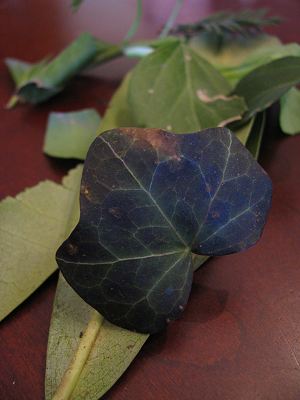
In my last post, I spoke a bit about the pedagogical theory behind experiential, tactile learning.
Children are filing the experience away as part of their wealth of knowledge. The experience creates the genuine need and desire for new vocabulary, concepts, and other lessons. The ideas and facts can then “stick” to these experiences, much like Velcro.
Digging into dirt is a fascinating task for young kids and there is so much to learn! You can find out more about the creatures that tunnel underground, like earthworms, ants, rodents, and more. You can learn about growing plants and their importance in our eco-system. You can test soil to see what might grow there. And junior gardeners and botanists are more likely to be healthy eaters, as well. Children involved in the production of their own food are generally more likely to try new foods and to understand the connection between eating and nutrition!
So, I was very excited to hear about Kindercare’s Spring Camp: The Secret Science of Dirt. They’ve offered us a free week learning and playing at Kindercare in exchange for sharing information about the program with you. We can’t wait to dig-in! *thank you, I’ll be here all week!*
Spring break is still a few weeks away but we’re getting started at home with a fun little science experiment they sent us, courtesy of Science Adventures’ Andy the Science Wiz: Leaf Chromatography!
Materials
- plastic cups (or baby food jars)
- white coffee filter
- rubbing alcohol
- dime
- scissors
- tape
- a selection of leaves
Directions:
1. Collect a variety of green leaves.
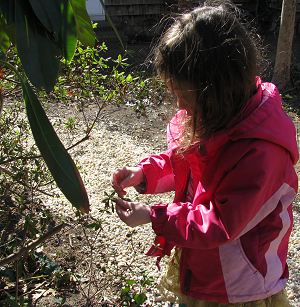
2. Cut the coffee filter into strips about one inch wide. Have an adult carefully pour ¼ inch of rubbing alcohol into a cup. Place one end of the filter strip under a leaf.
3. Help your child use the edge of a dime to rub back and forth on the leaf a few times. This will rub some of the leaf’s color onto the filter paper; you should be able to see a green line.
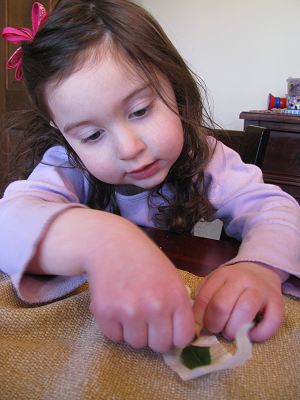
4. Place the filter paper in the glass so the bottom of the filter touches the alcohol with the green line just above the alcohol. Use a piece of tape to hold the filter paper in place and leave everything undisturbed for an hour. After an hour, check the filter paper and discuss what you see!
Our results:
We got a little separation of yellow, green, and dark blue-green out of one of our leaves but nothing dramatic. I suspect this is because we have very slim pickings this early in the spring! We’ll try again once the maple leaves are out. Check out the more vivid results of a similar experiment at Ordinary Life Magic!
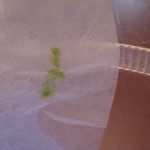
What is happening:
“Leaves are the food factories for plants. They use photosynthesis to turn light and carbon dioxide into carbohydrates. It is the chemicals responsible for photosynthesis that give leaves their color. Leaves are primarily green because the most common chemical found in leaves is green chlorophyll.
In your experiment, the alcohol dissolved the chemicals in the leaf and carried them up the paper spreading them out so they can be seen. Try different types of leaves to see if you can find different colors.”
More information on Chlorophyll Chromatography.
While you are waiting:
1. Carefully examine the other leaves. Have the children look closely at the leaves with a magnifying glass if available. What is the same about the leaves, what is different?
2. Paste leaves on a piece of paper and label some of the parts of the plant, such as tip, margin, vein, midrib, petiole, and blade.
—
Disclosure: Thank you to Kindercare’s Spring Camp: The Secret Science of Dirt for providing us with a free week of Spring Break camp and the experiment in this post. We have not yet attended the camp so this is not a review of their services. All opinions are my own as are all photographs in this post. Kindercare is a national program so check the website for a location near you!
Shared at: Science Sundays
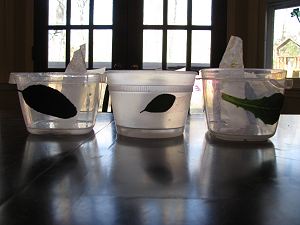
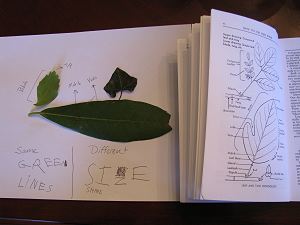


This is neat-I’ve never tried to take green off of leaves. The free dirt camp sounds exciting. Have fun!